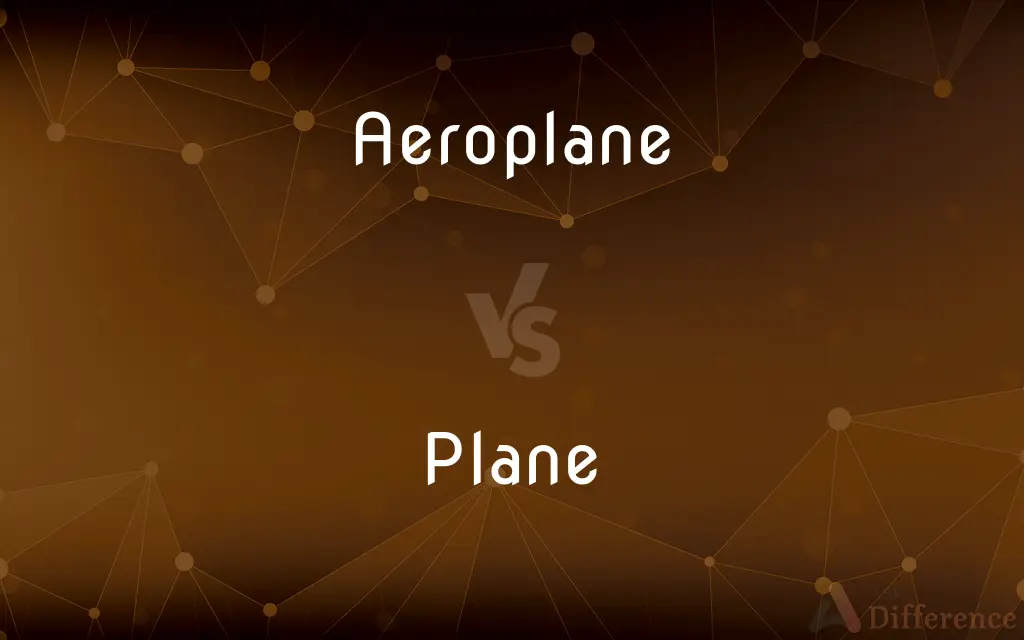Aeroplane vs. Plane — What's the Difference?
By Fiza Rafique & Maham Liaqat — Updated on March 24, 2024
An aeroplane, specifically referring to fixed-wing aircraft powered by propellers or jets, is designed for air travel. Plane, a more general term, can refer to any type of aircraft or even to concepts in geometry.

Difference Between Aeroplane and Plane
Table of Contents
ADVERTISEMENT
Key Differences
An aeroplane is a type of aircraft that is characterized by its fixed-wing structure and is typically propelled forward by thrust from jet engines or propellers. This design is essential for achieving and maintaining flight. On the other hand, the term plane can be used to describe any type of aircraft, including aeroplanes, helicopters, gliders, and more. It's a broader category that encompasses a wide range of aerial vehicles.
While aeroplanes are specifically engineered for atmospheric flight, planes as a category might also include vehicles designed for space travel, such as spaceplanes, which can operate both in the atmosphere and in outer space. This distinction highlights the aeroplane's limitation to atmospheric flight, whereas "plane" can refer to vehicles capable of operating beyond this boundary.
Aeroplanes are often associated with commercial air travel, transporting passengers and cargo across vast distances efficiently. In contrast, planes could also refer to military aircraft designed for combat, surveillance, or other defense-related purposes. This diversity underscores the aeroplane's role in civil aviation, while the term plane covers a broader spectrum of functions and designs.
The development of aeroplanes has been marked by a focus on enhancing speed, fuel efficiency, and carrying capacity. Meanwhile, innovations in the broader category of planes have also explored vertical takeoff and landing capabilities, stealth technology, and unmanned aerial vehicles (UAVs). This indicates that while aeroplanes prioritize efficiency and capacity, the field of planes is more diverse, focusing on various performance and operational needs.
Aeroplanes typically require runways for takeoff and landing, a characteristic that defines much of their design and operational requirements. Conversely, some planes, such as helicopters and certain drones, can take off and land vertically, eliminating the need for runways. This comparison highlights the aeroplane's dependence on specific infrastructure, while the term plane includes vehicles with more flexible operational capabilities.
ADVERTISEMENT
Comparison Chart
Definition
A fixed-wing aircraft powered by engines.
Any type of aircraft or concepts in geometry.
Usage
Primarily for atmospheric travel.
Can refer to both atmospheric and space travel.
Associated With
Commercial and some military uses.
Broad range including commercial, military, and space.
Design Focus
Speed, efficiency, and carrying capacity.
Includes vertical takeoff, stealth, and UAVs.
Operational Needs
Requires runways for takeoff and landing.
Includes vehicles that do not require runways.
Compare with Definitions
Aeroplane
A powered flying vehicle with fixed wings.
The aeroplane soared high, leaving a trail of white clouds.
Plane
Used to describe vehicles in both air and space.
The new design could function as both a plane and a spacecraft.
Aeroplane
Commercial aeroplanes carry passengers and cargo.
The commercial aeroplane was fully booked for the international flight.
Plane
The term can also refer to geometric planes.
In geometry, a plane is defined by three non-collinear points.
Aeroplane
A vehicle designed for air travel using engines.
She always dreamed of piloting an aeroplane.
Plane
Some planes are designed for vertical takeoff and landing.
The innovative plane landed vertically in the middle of the field.
Aeroplane
Military aeroplanes are used for defense and combat.
The military aeroplane flew over the coast on a routine patrol.
Plane
Any type of aircraft, including helicopters and gliders.
The plane hovered above the treetops, searching for a landing spot.
Aeroplane
Aeroplanes can be propelled by jet engines or propellers.
The small aeroplane's propeller spun rapidly as it prepared for takeoff.
Plane
Planes vary widely in design and purpose.
The museum displayed planes from different eras of aviation.
Aeroplane
A powered flying vehicle with fixed wings and a weight greater than that of the air it displaces.
Plane
(Mathematics) A surface containing all the straight lines that connect any two points on it.
Aeroplane
Variant of airplane.
Plane
A flat or level surface.
Aeroplane
A powered heavier-than-air aircraft with fixed wings.
Plane
A level of development, existence, or achievement
Scholarship on a high plane.
Aeroplane
An airfoil.
Plane
An airplane or hydroplane.
Aeroplane
Any of various nymphalid butterflies, of various genera, having a slow gliding flight. Also called planes.
Plane
A supporting surface of an airplane; an airfoil or wing.
Aeroplane
(intransitive) To fly in an aeroplane.
Plane
A carpenter's tool with an adjustable blade for smoothing and leveling wood.
Aeroplane
(transitive) To transport by aeroplane.
Plane
A trowel-shaped tool for smoothing the surface of clay, sand, or plaster in a mold.
Aeroplane
A light rigid plane used in aërial navigation to oppose sudden upward or downward movement in the air, as in gliding machines; specif., such a plane slightly inclined and driven forward as a lifting device in some flying machines. Also called airfoil.
Plane
The plane tree.
Aeroplane
An aircraft that has a fixed wing and is powered by propellers or jets;
The flight was delayed due to trouble with the airplane
Plane
(Mathematics) Of or being a figure lying in a plane
A plane curve.
Plane
Flat; level.
Plane
To smooth or finish with a plane
Planed the door.
Plane
To remove with a plane
Plane off the rough edges on a board.
Plane
To work with a plane.
Plane
To rise partly out of the water, as a hydroplane does at high speeds.
Plane
To soar or glide.
Plane
To travel by airplane.
Plane
Of a surface: flat or level.
Plane
A level or flat surface.
Plane
(geometry) A flat surface extending infinitely in all directions (e.g. horizontal or vertical plane). Category:en:Surfaces
Plane
(anatomy) An imaginary plane which divides the body into two portions.
Plane
A level of existence or development.
Astral plane
Plane
A roughly flat, thin, often moveable structure used to create lateral force by the flow of air or water over its surface, found on aircraft, submarines, etc. (Compare airfoil, hydrofoil.)}}
Plane
Any of 17 designated ranges of 216 (65,536) sequential code points each.
Plane
A tool for smoothing wood by removing thin layers from the surface.
Plane
An airplane; an aeroplane.
Plane
(entomology) Any of various nymphalid butterflies, of various genera, having a slow gliding flight.
Plane
(entomology) The butterfly Bindahara phocides, family Lycaenidae, of Asia and Australasia.
Plane
(countable) A deciduous tree of the genus Platanus.
Plane
(Northern UK) A sycamore.
Plane
To smooth (wood) with a plane.
Plane
To move in a way that lifts the bow out of the water.
Plane
To glide or soar.
Plane
Any tree of the genus Platanus.
Plane
A surface, real or imaginary, in which, if any two points are taken, the straight line which joins them lies wholly in that surface; or a surface, any section of which by a like surface is a straight line; a surface without curvature.
Plane
An ideal surface, conceived as coinciding with, or containing, some designated astronomical line, circle, or other curve; as, the plane of an orbit; the plane of the ecliptic, or of the equator.
Plane
A block or plate having a perfectly flat surface, used as a standard of flatness; a surface plate.
Plane
A tool for smoothing boards or other surfaces of wood, for forming moldings, etc. It consists of a smooth-soled stock, usually of wood, from the under side or face of which projects slightly the steel cutting edge of a chisel, called the iron, which inclines backward, with an apperture in front for the escape of shavings; as, the jack plane; the smoothing plane; the molding plane, etc.
Plane
Without elevations or depressions; even; level; flat; lying in, or constituting, a plane; as, a plane surface.
Plane
To make smooth; to level; to pare off the inequalities of the surface of, as of a board or other piece of wood, by the use of a plane; as, to plane a plank.
Plane
To efface or remove.
He planed away the names . . . written on his tables.
Plane
Figuratively, to make plain or smooth.
What student came but that you planed her path.
Plane
Of a boat, to lift more or less out of the water while in motion, after the manner of a hydroplane; to hydroplane.
Plane
An aircraft that has a fixed wing and is powered by propellers or jets;
The flight was delayed due to trouble with the airplane
Plane
(mathematics) an unbounded two-dimensional shape;
We will refer to the plane of the graph as the X-Y plane
Any line joining two points on a plane lies wholly on that plane
Plane
A level of existence or development;
He lived on a worldly plane
Plane
A power tool for smoothing or shaping wood
Plane
A carpenter's hand tool with an adjustable blade for smoothing or shaping wood;
The cabinetmaker used a plane for the finish work
Plane
Cut or remove with or as if with a plane;
The machine shaved off fine layers from the piece of wood
Plane
Travel on the surface of water
Plane
Make even or smooth, with or as with a carpenter's plane;
Plane the top of the door
Plane
Having a horizontal surface in which no part is higher or lower than another;
A flat desk
Acres of level farmland
A plane surface
Common Curiosities
How is 'plane' different from 'aeroplane'?
'Plane' is a broader term that can refer to any type of aircraft or even concepts in geometry, whereas 'aeroplane' specifically refers to fixed-wing aircraft.
What defines an aeroplane's design?
An aeroplane's design is primarily focused on efficiency, speed, and carrying capacity, with fixed wings being a defining characteristic.
Are aeroplanes only used for commercial travel?
No, aeroplanes are used for both commercial air travel and military purposes, among other applications.
What is an aeroplane?
An aeroplane is a powered, fixed-wing aircraft that is propelled forward by thrust from an engine.
How do innovations in plane technology differ from those in aeroplanes?
Innovations in plane technology encompass a broader range, including stealth technology, UAVs, and vertical takeoff and landing capabilities, whereas aeroplane innovations focus on efficiency and capacity.
Are all planes capable of atmospheric travel?
While most planes are designed for atmospheric travel, the term can also encompass vehicles designed for space travel.
Can the term 'plane' refer to helicopters?
Yes, 'plane' can refer to any aircraft, including helicopters, which do not have fixed wings.
Do aeroplanes always require runways?
Yes, aeroplanes typically require runways for takeoff and landing due to their design and operational requirements.
Are planes used in geometry?
Yes, in geometry, the term 'plane' refers to a flat, two-dimensional surface that extends infinitely in all directions.
What infrastructure do aeroplanes require?
Aeroplanes require airports with runways for takeoff and landing, as well as other support infrastructure for maintenance and passenger services.
Can a plane be a spacecraft?
Yes, in broader usage, 'plane' can refer to vehicles capable of operating in space, such as spaceplanes.
Do all planes have fixed wings like aeroplanes?
No, not all planes have fixed wings. For example, helicopters have rotating blades instead.
Is vertical takeoff and landing exclusive to planes and not aeroplanes?
Yes, aeroplanes typically require runways, while some planes, like certain drones and helicopters, can take off and land vertically.
Can aeroplanes operate in space?
No, aeroplanes are designed for atmospheric travel and cannot operate in space.
What are military aeroplanes used for?
Military aeroplanes are used for a variety of purposes, including combat, surveillance, and transport.
Share Your Discovery

Previous Comparison
Omniscient vs. Omnipotent
Next Comparison
Hiking vs. TrekkingAuthor Spotlight
Written by
Fiza RafiqueFiza Rafique is a skilled content writer at AskDifference.com, where she meticulously refines and enhances written pieces. Drawing from her vast editorial expertise, Fiza ensures clarity, accuracy, and precision in every article. Passionate about language, she continually seeks to elevate the quality of content for readers worldwide.
Co-written by
Maham Liaqat














































